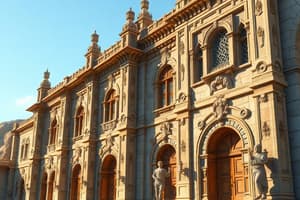Podcast
Questions and Answers
Explain the classification of stone masonry based on the arrangement of stones and the degree of refinement used in shaping the stone and finishing adopted.
Explain the classification of stone masonry based on the arrangement of stones and the degree of refinement used in shaping the stone and finishing adopted.
Stone masonry can be classified into Rubble Masonry and Ashlar Masonry. Rubble masonry includes Random Rubble (Uncoursed and Built to courses), Square Rubble (Uncoursed, Built to courses, Regular coursed), and Miscellaneous types (Polygonal walling, Flint walling). Ashlar masonry involves more refined and precisely shaped stones.
What are the characteristics of rubble masonry? Provide examples of the types of rubble masonry.
What are the characteristics of rubble masonry? Provide examples of the types of rubble masonry.
Rubble masonry uses undressed or roughly dressed stones with wide joints due to irregular sizes. Examples of types include Random Rubble (Uncoursed and Built to courses), Square Rubble (Uncoursed, Built to courses, Regular coursed), and Miscellaneous types (Polygonal walling, Flint walling).
How do larger stones contribute to the construction of dry rubble masonry?
How do larger stones contribute to the construction of dry rubble masonry?
Larger stones are selected for quoins and jambs to give increased strength and better appearance in dry rubble masonry.
What is dry rubble masonry and what are its characteristics?
What is dry rubble masonry and what are its characteristics?
Explain the importance of sound bond in dry rubble masonry.
Explain the importance of sound bond in dry rubble masonry.
Flashcards are hidden until you start studying





